To maximize your business’s earning potential, you need to understand how clients interact with your business and use those insights to create better marketing campaigns. A customer journey map is a vital tool that will help you reach that level of customer understanding and boost your earning potential.
However, customer journey mapping alone is not enough to drive conversions and revenue. You need to build marketing campaigns that will convince your leads to subscribe or make a purchase. By integrating email marketing into the customer journey, your email subscribers and potential customers receive content relevant to their position in the decision-making process.
This post will walk you through four ways to use email marketing as part of the customer journey. But first, let’s explore what customer journey mapping entails.
Content:
- What is customer journey mapping?
- How to sync your customer journey and email marketing
- Reimagine the customer experience
- Awareness
- Consideration
- Purchase
- Loyalty
- Optimize your touchpoints
- The sign up touchpoint
- The content touchpoint
- The CTA touchpoint
- Follow through after a purchase
- Thank you emails
- Promotional emails
- Survey emails
- Re-engage your customers
- Wrapping up
What is customer journey mapping?
A customer journey map is a diagram showing each stage of a customer’s interaction with your business. Also known as a user journey or UX map, a customer journey map helps you understand what excites or turns off your customers. Most customer journey maps contain the four key stages below:
- awareness;
- consideration;
- purchase or decision;
- delight or loyalty.
Let’s say you’re looking for a child care center for your child:
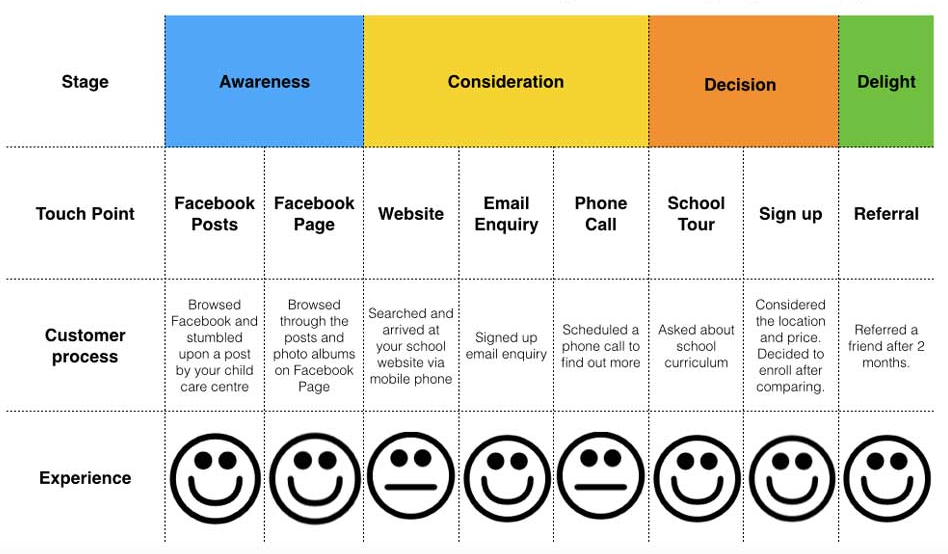
The customer journey map lists not just the four key stages, but also the touchpoints and actions that the customer takes. Even though there are more elements to the customer journey, understanding these four phases allows you to put yourself in a customer’s shoes, predict their needs, and provide a satisfying experience.
How to sync your customer journey and email marketing
Email marketing is undoubtedly effective, with a $36 return on every dollar invested. But without a clearly defined email marketing strategy, you won’t be able to realize its full benefits.
The goal of every campaign is to reach the right audience with the right message. That is the very reason email marketers segment their mailing lists and curate their content.
Integrating email marketing strategies into your customer journey map will improve your customer service immensely by keeping your customers engaged and showing them the value you have to offer.
Reimagine the customer experience
The first step you need to take is to put yourself in your prospect’s shoes and think of ways to improve the experience. For instance, if you run a web design business, you need to imagine how potential customers encounter your brand for the first time.
Most users will find your business through a Google search. They will then look at your portfolio and pricing before deciding to contact you. All of these steps are touchpoints or events where you can connect with the customer, provide value, and guide them along the journey.
Let’s look at the customer journey and the type of email content that’s appropriate for each step.
Awareness
At this stage, prospects don’t know you or your business. You need to help them discover your brand and make them aware of what you can do. You can do this by creating content that’s relevant to your niche. This content typically discusses industry topics and answers common questions for that audience.
Some examples of content that raises awareness include:
- infographics;
- blog posts;
- how-to articles;
- podcasts and videos.
This type of content helps establish your business as credible and informative. It’s a great way to boost your rankings on search pages as well.
Consideration
At this stage, prospects research their options and select brands that offer the best solutions to their problem.
According to Pardot, buyers intent on making a purchase search for their interests on Google 2 or 3 times before deciding which option to buy. This statistic implies that prospects consider how a business can solve their pain points in decision making. Prospects usually look at testimonials, reviews, the relevance of your content, and, most importantly, price during their decision-making process.
Sending explainer videos for your services via email will give prospects a good idea of what they can expect from your product and send them to the next buyer journey stage.
Purchase
By now, the prospect has completed all the research they need and has shortlisted some options to solve their pain points. This is where you need to validate the worth of your solution.
At this stage, your email marketing content should convince the reader to choose your brand. For instance, you can offer a free trial or demo to get the user started. For even better results, add a clear CTA and expiration date. That way, you can get them to take action.
Here’s a great FOMO example from Thorne, a health supplement and wellness company.
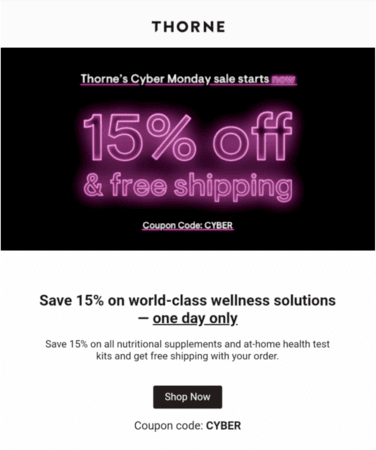
This example shows how to use limited time offers, discounts, and bonuses to increase conversions. The discount is not just substantial — it’s also hard to miss because of the way it’s presented. Free shipping is always a good incentive to buy, and the one-day promo period adds a sense of urgency for the reader.
Loyalty
After your customer makes a purchase, you need to remind them why they chose you in the first place. You can do that by sharing content that shows your value to your customers beyond the revenue they drive to your business.
Loyalty-centric content typically includes:
- help desks;
- walkthroughs;
- onboarding messages;
- in-app messages.
The trick to retaining customers is to make sure they’re getting the most out of their purchase.
By sending useful tips in your emails, your business adds value to the purchase by introducing customers to best practices that will help them use the solution more effectively. These tips also give customers an advantage over their peers or competitors by helping them work more efficiently.
Optimize your touchpoints
Your goal should be to remove as much manual work as possible. Automating and optimizing your touchpoints can help you reach more customers with a higher degree of efficiency. Let’s look at email marketing touchpoints and see how you can optimize each of them.
The sign up touchpoint
A subscription form allows your customers and prospects to sign up for a service you provide while giving you information to build a subscriber base. You can then send your customers occasional emails that are relevant to their needs.
Here are some tips you can use to create effective subscription forms:
- don’t ask for too much data;
- use inline field verification (validations that appear once a customer types in a form field) to check your forms in real-time;
- use placeholder texts as examples of what to write in a column;
- address errors with tip boxes.
Here’s an example of a form with inline field verification.
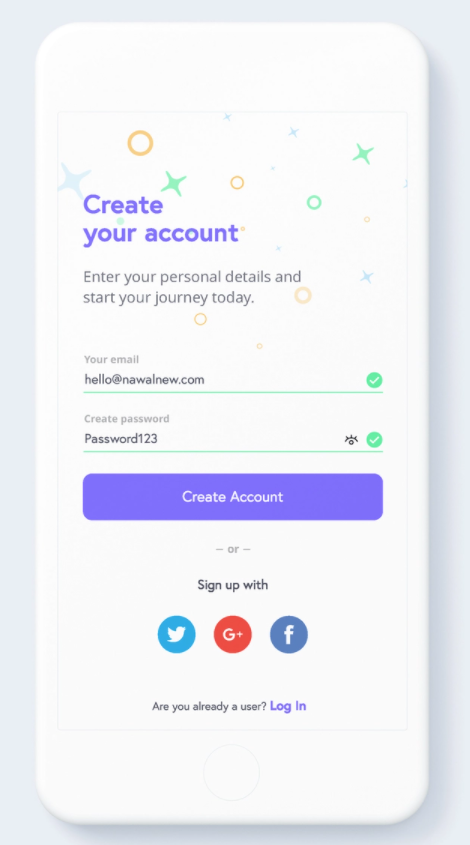
If the user inputs an invalid email address, the form will return an error message. If the email address is valid, however, the form will display a green check mark. This way, the user can correct mistakes before they click on “Create Account.”
The content touchpoint
One of the best things about email marketing is its potential for automation. You can schedule email content, create triggers that fire when prospects take specific actions, and much more.
However, you need to be careful of the content you send to customers. For instance, you can send first-time special discount emails to attract new customers, but sending that same email to your old customers will end up confusing them.
A content calendar helps you strategize and schedule your content. Ideally, the content you produce should follow a certain theme or topic. That will help set audience expectations. For example, one approach could be to create time-sensitive content for specific times of the year.
For example, content about keeping warm during the winter is more effective towards the end of the year, while articles about the Fourth of July are more likely to engage readers during spring or summer. You can set up your email automation platform to deliver the right content at the right time.
The CTA touchpoint
Finally, most marketing emails contain what we call a call to action (CTA). This is often a button that leads to a sales or landing page. For your email CTA button to work effectively, it should stand out and convince the reader to click through to your website.
Here are some elements that make up an effective email marketing CTA:
- Text. Your CTA should invite the reader to click on it. It should also be aligned with the rest of your email content. Using action words, such as “Register,” “Upgrade,” “Join,” and “Start” will give the reader an idea of what they’re supposed to do.
- Position. Most marketing experts agree that CTA buttons should be above the fold. However, they should also be below or to the side of the text, so the flow isn’t disrupted.
- Color. Your CTA buttons should stand out against the background. If your email uses a white background, a stronger color, such as green, blue, or red, draws the reader’s eyes to the CTA.
Also, automate your emails to be sent after specific actions on your webpage with email marketing tools like SendPulse. This way, your prospects get content related to their problems.
Follow through after a purchase
Have you ever wondered why you receive thank you emails after making certain purchases or paying for specific services?
It’s how businesses acknowledge and appreciate your decision to buy from them. It also shows interest in a continued relationship between you and the customer. To do this, you may set up automated emails that express your gratitude for them choosing your brand. This way, you can build customer relationships that last beyond the point of purchase.
Below are the types of automated emails that are the most common when it comes to following through after purchases.
Thank you emails
Businesses utilize thank you emails to establish better long-term customer loyalty. These kinds of emails help businesses generate customer engagement, which leads to increased brand loyalty.
Take a look at this thank you email from an SEO agency, The HOTH.
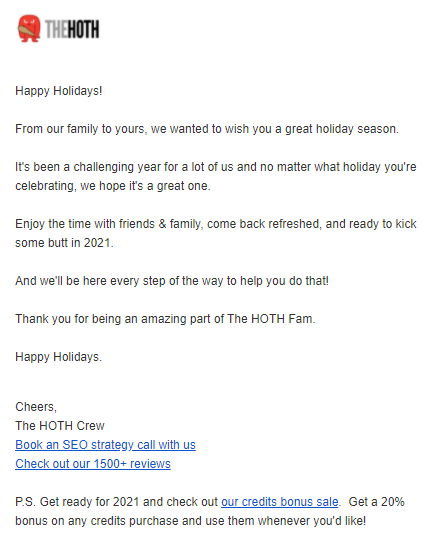
The above email acknowledges the challenges of the past year while still holding out hope for a better year ahead. It also takes a neutral tone to accommodate different cultural and religious holiday celebrations. Finally, it thanks the subscriber for being part of the HOTH family and assures them that the company will continue to serve them well.
Promotional emails
Promotional emails contain discounts, special offers, etc. for targeted customers as a thank you for joining your mailing list.
One way to do this is to promote the product or service you’re selling and then include some helpful content about it. For example, the email campaign from Simply Wall Street below entices you with a 30% discount on their Premium paid plan.
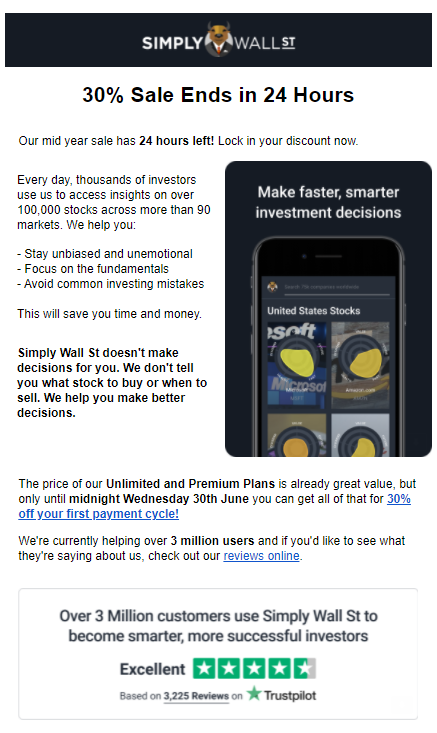
The promo email works in three ways. First, it offers a limited time discount of 30% that is set to expire in just 24 hours, which results in the customer subscribing to the service to get the preferential rate. Second, the copy explains what the plan can do for the customer. Finally, it seeks to convince the customer by using social proof such as reviews and trust badges.
Survey emails
Feedback plays a significant role in prospect conversion. Getting feedback about your products informs you on where and how to improve those products. Using survey emails, you can invite customers to answer a few questions about your product. You can then use their answers to create more effective campaigns.
This survey does not have to be lengthy. Below, Medium only asks its users how likely they are to recommend the platform to others.
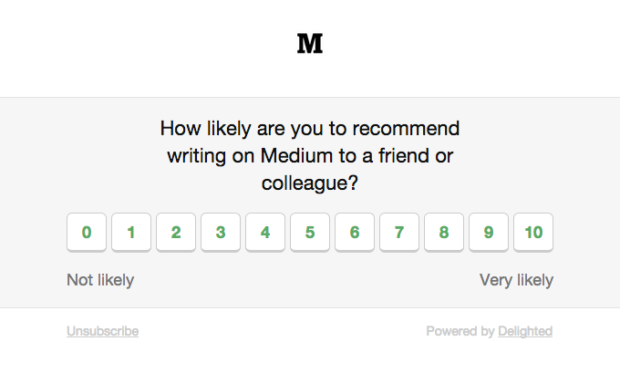
This survey produces a lot of feedback since it asks for only one answer. While it isn’t as accurate or targeted as a series of questions, the survey above gives Medium’s site owners a good idea of customer sentiment.
Re-engage your customers
Your competitors are constantly trying to attract your customers with better products and services. You need to charm your customers into sticking with you. Give them a reason to make you the go-to brand. Consider sending emails that highlight your company’s milestones or build customer loyalty through discounts, exclusive content, and product reviews.
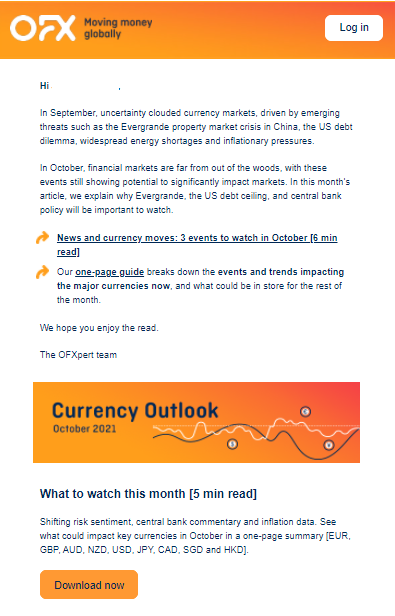
Forex platform OFX, for example, sends a monthly digest that contains news about events that could have an impact on its customers. By keeping its customers informed, they are able to make better decisions about trading foreign currencies.
Sending regular emails to consumers regarding their status in your business is an excellent method to remind them about your loyalty. In fact, 45% of customers who received re-engagement emails continued to read subsequent emails, leading to more future purchases.
Wrapping up
Customer journey mapping is highly beneficial to your business. It allows you to convert prospects into loyal customers efficiently.
However, note that prospects and customers are also human. They tend to change as time goes by. So you need to adapt to their consumer behaviors to keep satisfying them long term.








